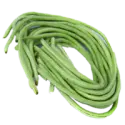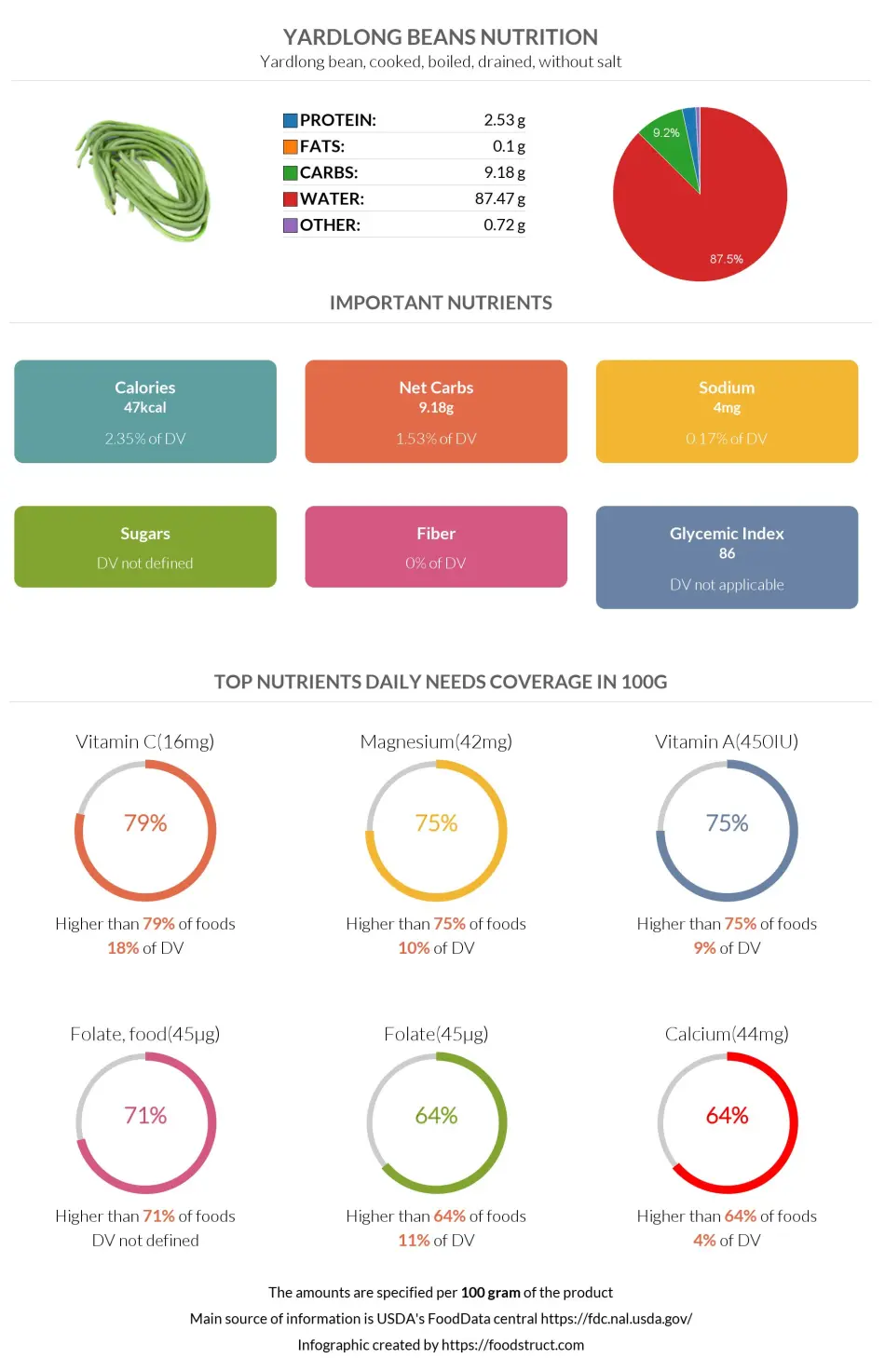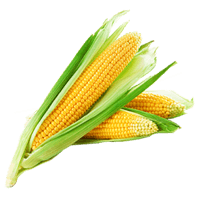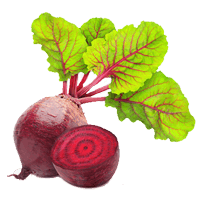Yardlong beans nutrition: calories, carbs, GI, protein, fiber, fats

Introduction
The yardlong bean, also known as the Chinese snake bean, pea bean, or asparagus bean, is a tender, edible pod of the Vigna unguiculata plant. Even though yardlong beans are highly popular, we're sure that not everyone is aware of their nutritional value and health benefits.
Yardlong beans are high in vitamins and minerals, making them a nutritious addition to healthy diets. The beans are the most popular pod vegetables in East Asian cuisines. Yardlong beans are also grown on small scales in the gardens.
General Information
Classification
Yardlong beans or asparagus beans are legumes cultivated for their edible pods. It belongs to the Vigna genus. Yardlong beans have alternative names: pea bean, long-podded cowpea, Chinese long bean, snake bean, etc.
Despite their superficial similarities, the yardlong is not very close to green beans. Despite both belonging to the legume family Fabaceae, unlike yardlong beans, green beans are part of the Phaseolus genus.
Yardlong bean is a variety of cowpeas.
Taste and Appearance
Yardbeans resemble overgrown green beans. As the name suggests, yardlong beans are much longer than typical green beans. They can grow up to 1 yard (3 feet or approximately 90cm) in length, although they are usually harvested when they are about half that size for tenderness.
These beans are usually green, similar to common green beans, but they can also come in varieties with purple, red, or yellow pods.
The plant leaves are bright green, with three heart-shaped leaves. The flowers and the resulting bean pods usually form connected pairs.
The raw pods may sometimes have a mushroom flavor. Their texture is crisp and tender. Ripe seeds can be used, dried for storage, and then cooked as legumes. Young leaves and stem tips can be steamed like a vegetable.
Varieties
There are several varieties of yardlong beans, each with its own unique characteristics. Some popular varieties of yardlong beans include:
- Red Noodle Bean: This variety is known for its striking bright red pods. The beans are long and slender, reaching up to 18 inches in length. They are often used in stir-fries and curries.
- Green Noodle Bean: Similar to the Red Noodle Bean, this variety has green pods. It is prized for its tenderness and is commonly used in Asian cuisine.
- Chinese Long Bean: This is a traditional variety of yardlong beans with pale green pods. It is a common ingredient in Chinese and Southeast Asian dishes. Chinese Long Beans can grow up to 30 inches in length.
- Purple Podded Yardlong Bean: As the name suggests, this variety has purple-colored pods. The beans turn green when cooked. It is valued for its ornamental appeal as well as its culinary uses.
- Black-Seeded Yardlong Bean: This variety is known for its black seeds. The pods are green and long, and the beans have a slightly nutty flavor. They are often used in stir-fries and soups.
Other popular varieties are Big Red Yardlong Bea, Thailand Long Bean, and Bauhinia Bean.
Cultivation
Yardlong beans thrive in warm climates with full sun. They require well-drained soil with good organic matter. The ideal soil pH is around 6.0 to 6.8.
This vegetable, a traditional food plant in Africa, can improve nutrition, increase food security, promote rural development, and support sustainable agriculture. Since beans are legumes, you can use them to till the soil before planting. Coating the seeds with an inoculant will help the plants take nitrogen from the air.
Yardlong beans are one of Southeast Asia's most popular vegetables, particularly in southern China and Bangladesh. It is the most widely grown legume in the Philippines and is known as "poor man's meat." Yardlong beans are often grown as a little garden vegetable in some lowland tropical countries. It became popular in the Caribbean and is grown as a summer crop in California and parts of Europe, especially as a greenhouse vegetable.
Nutrition
Yardlong beans are very low-calorie vegetables. Yardlong beans have many beneficial nutritional compounds. The nutritional information below will focus on 100g servings of boiled and drained yardlong beans without salt.
The average serving size of cooked yardlong beans per person is one cup of these beans in slices, weighing about 104g.
Cooked yardlong beans are not very nutritionally dense, consisting of 85% water and 15% nutrients. Of those nutrients, 10% are carbohydrates, and the other 5% are proteins, fats, and micronutrients.
Macronutrients chart
Calories
As mentioned above, cooked yardlong beans are very low-calorie vegetables.
Boiled yardlong beans provide only 47 calories per 100g serving.
However, the same serving size of boiled mature yardlong beans provides 118 calories (1).
Vitamin coverage chart
Minerals
Yardlong beans are relatively rich in minerals as well. It is high in magnesium, iron, and potassium. It falls in the top 25% of foods as a source of magnesium, containing 44mg per 100g.
A 100g serving of boiled yardlong beans covers 12% of the daily iron needed and 10% of the required magnesium amount.
These beans also fall in the top 36% and 39% of foods as a source of calcium and potassium, respectively. They contain sufficient amounts of copper, selenium, and zinc.
Unsalted boiled yardlong beans contain very low sodium, only around 4mg in a 100g serving. However, the same serving size of yardlong beans, boiled with salt, provides 240mg of sodium (3).
Mineral coverage chart
Glycemic Index
Studies have found different numbers for the glycemic index value of yardlong beans. One study found this number to be 43, while another calculated it to be 86 (4, 5).
However, based on the low carbohydrate content of yardlong beans, their glycemic index value is most likely low - 43.
Weight Loss and Diets
Yardlong beans can be used in weight loss diets. They have a low-calorie count and no cholesterol, making these beans a perfect addition to a weight-loss diet (6).
| Keto | Yardlong beans are low in carbs, with a total carbohydrate content of 9.2g per 100g. The keto nutrient ratio is 70% fat, 20-25% protein, and 5-10% carbohydrates, which means that most of your meals should be low-carb and high-fat. So, with some forethought, you can include yardlong beans in moderation (7). |
| DASH | DASH is an abbreviation for dietary approaches to hypertension. It is intended to lower blood pressure through dietary choices (8). Since unsalted yardlong beans have low sodium content, they can be included in your DASH diet. You can include unsalted yardlong beans in your list of recommended products.. |
| Atkins | Atkins is a low-carb diet. This diet claims that you can lose weight by eating as much protein and fat as you want as long as you avoid high-carb foods. Similar to the keto diet, yardlong beans can be used in this diet only in moderation (9). |
| Mediterranean | A high intake of fruits, vegetables, legumes, nuts, beans, fish, and unsaturated fats characterizes the Mediterranean diet. It typically includes a low intake of meat and dairy products and a high intake of olive oil (10). Yearlong beans are vegetables rich in vitamins and micronutrients, making them a perfect fit for this diet. They're also cost-effective and can add incredible flavor and texture to your meals. |
| Paleo | Overall, the paleo diet includes meats, fish, vegetables, nuts, fruits, and seeds (11). This diet excludes dairy products, legumes, and grains. Therefore, yardlong beans should be avoided in this diet. |
| Vegan/ Vegetarian/ Pescetarian | A vegan, vegetarian, and pescetarian diets contain vegetables, grains, nuts, legumes, fruits, and seeds. You can use yardlong beans in these diets. |
| Gluten-free | A gluten-free diet eliminates gluten-containing foods. Gluten is the protein found in wheat, barley, and triticale grains. A gluten-free diet can help you manage the symptoms of celiac disease and other gluten-related medical conditions (12). You can use yardlong beans and other vegetables in this diet. |
| Dukan | The Dukan diet is characterized by eating large amounts of lean meat, poultry, fish, shellfish, low-fat dairy products, and eggs (13). Yardlong beans are allowed in the Cruise phase of the Dukan die. |
| Intermittent Fasting | Intermittent fasting does not specify which foods to eat but rather when they should be consumed. Intermittent fasting has several methods that divide the day or week into eating and fasting periods. You can be fasting for 16 hours a day and eating only during an 8-hour window. The 16/8 method is the most popular form of this diet (14). Like all foods, you can use yardlong beans on this diet during eating periods but should refrain from during fasting periods. |
| Low Fat & Low Calorie | Yardlong beans are naturally very low in fats and calories. Yardlong beans can be used on these diets due to their low fat and calorie content. |
| Low Carb | Asparagus beans can be used on this diet in moderation. |
| Anti Inflammatory | Yardlong beans contain antioxidants, such as vitamin C and anthocyanins, which have been researched to have anti-inflammatory qualities (15). Therefore, these beans can be used in this diet. |
| BRAT | The BRAT diet has been suggested to treat stomach flu, diarrhea, and other stomach problems. Beans are not recommended on this diet, as their fiber content may worsen diarrhea. |
Health Impact
This section of the article covers the benefits and downsides of yardlong beans on human health.
Cardiovascular Health
Consumption of yardlong beans may help prevent some heart diseases due to their nutritional content.
Yardlong beans are high in magnesium, which may aid in relaxing the smooth heart muscle, reducing the risk of a heart attack. A daily intake of magnesium can help reduce the risk of high blood pressure by 5% (16).
Diabetes
Yardlong beans are low in total carbohydrates and have a low glycemic index value, meaning the consumption of these beans does not increase blood glucose levels rapidly.
Research has found yardlong beans can help prevent health complications, such as diabetes and obesity, due to their nutritional content (17).
Cancer
Antioxidants are essential for the body; they help fight against free radicals, the leading mechanisms of tumor cell formation. Yardlong beans are a good source of potent antioxidants, providing vitamin C and anthocyanins. These antioxidant properties may prevent some types of cancer (15).
Gout
Gout is a common type of arthritis that can affect anyone at any age. It is characterized by sudden, severe pain, swelling, redness, and tenderness in one or more joints, most often in the big toe. Gout is caused by the high content of uric acid, which forms crystals in the joints. According to one study, those who consumed 1,000–1499mg of vitamin C were less likely to develop gout (18). Yardlong beans are a great source of vitamin C.
However, according to research, boiled yardlong beans provide almost 60mg of total purines per 100g serving (19). Therefore, these beans should be consumed in moderation for people with gout.
Immune System
Yardlong beans are a great source of vitamin C, a powerful antioxidant that can strengthen your body’s natural defenses. Antioxidants are molecules that strengthen the immune system. They can protect cells from harmful molecules like free radicals.
Based on studies, consuming more vitamin C can raise blood antioxidant levels by up to 30%. It helps the body's natural defenses fight inflammation (20).
Skin Health
Yardlong beans are a great source of antioxidants that can prevent acne and age spots.
Yardlong beans contain a high level of vitamin A. At 450IU per 100g, yardlong beans contain more of this vitamin than other legumes of the same family, such as lima beans, fava beans, green beans, etc. Vitamin A is one of the essential vitamins provided by the body through food. Vitamin A maintains mucosal integrity and enhances skin complexion (21).
Pregnancy
Yardlong bean is a practical vegetable during pregnancy that provides a variety of health benefits. It is rich in vitamins such as vitamin C, folate, and vitamin A. It contains minerals such as magnesium and potassium.
Besides, 100g beans provide 45mg of folate (vitamin B9) or 11% of the daily required value for this vitamin. Adequate folate intake before and during pregnancy aids in the prevention of neural tube defects in newborns.
Disadvantages and Risks
While yardlong beans have impressive health benefits, some people should avoid their consumption.
Allergy
People with allergies to legumes should avoid the consumption of yardlong beans.
Some people who are allergic to legumes are sensitive to all types of legumes. Common allergy symptoms include abdominal pain and vomiting, itching, redness of the skin, and hives, often around the mouth. Symptoms of severe cases may include wheezing and anaphylaxis. Some people may develop a rash when the skin comes in contact with legumes.
As with other types of food allergies, the primary approach is to identify and avoid cross-reactive legumes. Cooked legumes can be more allergenic than raw legumes. Even bean protein inhaled through cooking smoke can trigger an allergic reaction, such as asthma (22).
Cooking and Uses
Yardlong beans taste best when fried or deep-fried in oil; the flavor is enhanced while the texture remains firm and juicy. They are also delicious when cooked and served as a salad or in stews.
Yardlong beans are often cooked in woks. The plants' young leaves are usually cooked like spinach and eaten as a vegetable in the tropics. Yardlong bean shoots are sometimes referred to as asparagus beans because they can be utilized similarly to asparagus.
Storage, Keeping, and Conservation
Yardlong beans have a concise shelf life and can spoil quickly if not stored properly. Furthermore, high temperatures are hazardous to yard beans because they do not keep fresh for long at room temperature.
Suppose you bought yardlong beans and plan to use them throughout the day. In that case, you can store them at room temperature for a while but do not store them at room temperature if you plan to use them tomorrow or later.
The best and safest way to store your garden beans is to keep them in the refrigerator. Because you cannot store yardlong beans at high temperatures, the refrigerator is the best and safest place to keep them. You can keep them fresh for almost 2 weeks by storing them in the refrigerator. If you want to keep them fresh longer, you can store them in the freezer; then, they will stay fresh for at least 6 months (23).
Sources
- https://fdc.nal.usda.gov/fdc-app.html#/food-details/174282/nutrients
- https://www.researchgate.net/publication/363573307
- https://fdc.nal.usda.gov/fdc-app.html#/food-details/169359/nutrients
- https://www.ncbi.nlm.nih.gov/pmc/articles/PMC7791047/
- https://ojs.uajy.ac.id/index.php/biota/article/view/2879
- https://pubmed.ncbi.nlm.nih.gov/19939654/
- https://www.ncbi.nlm.nih.gov/pmc/articles/PMC3945587/
- https://pubmed.ncbi.nlm.nih.gov/10410299/
- https://www.ncbi.nlm.nih.gov/pmc/articles/PMC5090657/
- https://www.ncbi.nlm.nih.gov/pmc/articles/PMC6801699/
- https://www.ncbi.nlm.nih.gov/pmc/articles/PMC8004139/
- https://www.ncbi.nlm.nih.gov/pmc/articles/PMC6213115/
- https://pubmed.ncbi.nlm.nih.gov/26024402/
- https://pubmed.ncbi.nlm.nih.gov/25857868/
- https://www.researchgate.net/publication/41396636
- https://www.ncbi.nlm.nih.gov/pmc/articles/PMC5629161/
- https://www.mdpi.com/2073-4395/12/9/2195
- https://jamanetwork.com/journals/jamainternalmedicine/article-abstract/414828
- https://www.kimika.pfcs.org.ph/index.php/kimika/article/view/163/153
- https://www.ncbi.nlm.nih.gov/pmc/articles/PMC1541262/
- https://ods.od.nih.gov/factsheets/VitaminA-HealthProfessional/
- https://pubmed.ncbi.nlm.nih.gov/22555630/
- https://www.sciencedirect.com/science/article/pii/B978012821450300010X#
Top nutrition facts for Yardlong beans

| Calories ⓘ Calories for selected serving | 47 kcal |
|
Glycemic index ⓘ
Source:
Check out our Glycemic index chart page for the full list.
|
86 (high) |
| Glycemic load | 8 (low) |
| Net Carbs ⓘ Net Carbs = Total Carbohydrates – Fiber – Sugar Alcohols | 9 grams |
| Default serving size ⓘ Serving sizes are mostly taken from FDA's Reference Amounts Customarily Consumed (RACCs) | 1 cup slices (104 grams) |
| Acidity (Based on PRAL) ⓘ PRAL (Potential renal acid load) is calculated using a formula. On the PRAL scale the higher the positive value, the more is the acidifying effect on the body. The lower the negative value, the higher the alkalinity of the food. 0 is neutral. | -4.4 (alkaline) |
| Oxalates ⓘ https://www.mdpi.com/2304-8158/12/17/3201 | 29 mg |
Yardlong beans calories (kcal)
| Calories for different serving sizes of yardlong beans | Calories | Weight |
|---|---|---|
| Calories in 100 grams | 47 | |
| Calories in 1 pod | 7 | 14 g |
| Calories in 1 cup slices | 49 | 104 g |
| Calories for different varieties of yardlong beans | Calories | Weight |
|---|---|---|
| Yardlong bean, cooked, boiled, drained, without salt (this food) | 47 | 100 g |
| Yardlong bean (Asparagus bean) raw | 47 | 100 g |
| Yardlong bean, cooked, boiled, drained, with salt | 47 | 100 g |
Yardlong beans Glycemic index (GI)
Yardlong beans Glycemic load (GL)
Mineral chart - relative view
Vitamin chart - relative view
All nutrients for Yardlong beans per 100g
| Nutrient | Value | DV% | In TOP % of foods | Comparison |
| Vitamin A | 23µg | 3% | 42% | |
| Calories | 47kcal | 2% | 88% |
Equal to Orange
|
| Protein | 2.5g | 6% | 74% |
1.1 times less than Broccoli
|
| Fats | 0.1g | 0% | 93% |
333.1 times less than Cheese
|
| Vitamin C | 16mg | 18% | 21% |
3.3 times less than Lemon
|
| Net carbs | 9.2g | N/A | 47% |
5.9 times less than Chocolate
|
| Carbs | 9.2g | 3% | 50% |
3.1 times less than Rice
|
| Cholesterol | 0mg | 0% | 100% |
N/A
|
| Vitamin D | 0µg | 0% | 100% |
N/A
|
| Magnesium | 42mg | 10% | 25% |
3.3 times less than Almonds
|
| Calcium | 44mg | 4% | 36% |
2.8 times less than Milk
|
| Potassium | 290mg | 9% | 39% |
2 times more than Cucumber
|
| Iron | 0.98mg | 12% | 61% |
2.7 times less than Beef broiled
|
| Copper | 0.05mg | 5% | 82% |
3 times less than Shiitake
|
| Zinc | 0.36mg | 3% | 77% |
17.5 times less than Beef broiled
|
| Phosphorus | 57mg | 8% | 75% |
3.2 times less than Chicken meat
|
| Sodium | 4mg | 0% | 92% |
122.5 times less than White bread
|
| Selenium | 1.5µg | 3% | 79% | |
| Manganese | 0.2mg | 9% | 51% | |
| Vitamin B1 | 0.09mg | 7% | 53% |
3.1 times less than Pea raw
|
| Vitamin B2 | 0.1mg | 8% | 69% |
1.3 times less than Avocado
|
| Vitamin B3 | 0.63mg | 4% | 75% |
15.2 times less than Turkey meat
|
| Vitamin B5 | 0.05mg | 1% | 93% |
22.2 times less than Sunflower seeds
|
| Vitamin B6 | 0.02mg | 2% | 89% |
5 times less than Oats
|
| Vitamin B12 | 0µg | 0% | 100% |
N/A
|
| Folate | 45µg | 11% | 36% |
1.4 times less than Brussels sprouts
|
| Trans fat | 0g | N/A | 100% |
N/A
|
| Saturated fat | 0.03g | 0% | 90% |
226.7 times less than Beef broiled
|
| Monounsaturated fat | 0.01g | N/A | 93% |
1088.8 times less than Avocado
|
| Polyunsaturated fat | 0.04g | N/A | 91% |
1123.2 times less than Walnut
|
| Tryptophan | 0.03mg | 0% | 90% |
10.5 times less than Chicken meat
|
| Threonine | 0.09mg | 0% | 90% |
7.7 times less than Beef broiled
|
| Isoleucine | 0.14mg | 0% | 88% |
6.8 times less than Salmon raw
|
| Leucine | 0.18mg | 0% | 90% |
13.5 times less than Tuna Bluefin
|
| Lysine | 0.17mg | 0% | 87% |
2.7 times less than Tofu
|
| Methionine | 0.04mg | 0% | 91% |
2.7 times less than Quinoa
|
| Phenylalanine | 0.14mg | 0% | 88% |
4.8 times less than Egg
|
| Valine | 0.15mg | 0% | 89% |
13.9 times less than Soybean raw
|
| Histidine | 0.08mg | 0% | 87% |
9.1 times less than Turkey meat
|
Check out similar food or compare with current
NUTRITION FACTS LABEL
Serving Size ______________
Health checks
Yardlong beans nutrition infographic

References
All the values for which the sources are not specified explicitly are taken from FDA’s Food Central. The exact link to the food presented on this page can be found below.



